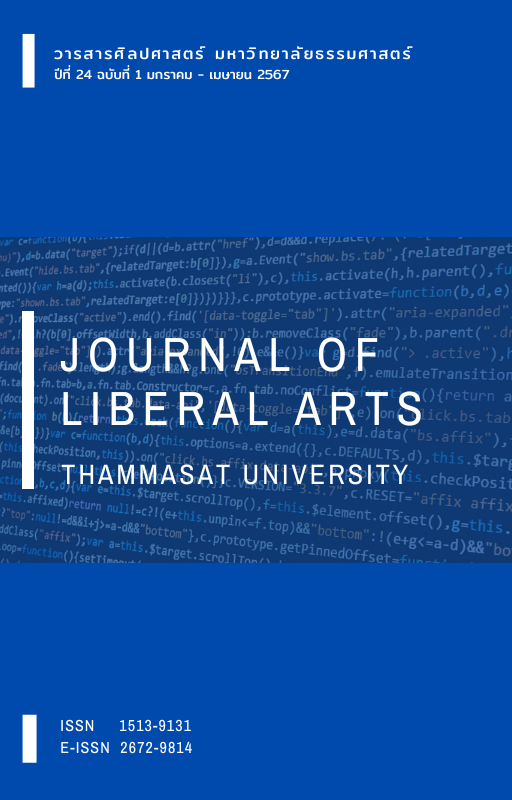An Analysis of the Structures of Adjacency Pairs in Cross-Examination in Chinese Courtroom Conversation
Main Article Content
Abstract
Based on the Theory of Conversation Analysis, taking real trial videos of China Court Trial Online as the source of the corpus, this paper employs a qualitative method to further clarify the categorization of phenomena such as incomplete turns and instances where listeners complete a speaker’s turn, examining whether they should be considered distinct conversational turns. Subsequently, this paper proceeds to conduct quantitative analyses of the structure types of adjacency pairs in cross-examination of court trials. It was found that the chain structure dominated by the “Enquire-Answer” accounted for the largest proportion, and the adjacent four-part structure of “Enquire-Answer-Repetition/Confirmation-Affirmation/Negation” type ranked second. The ring-type structure, which accounts for the third place, is mainly used together with other adjacent pairs comprehensively, and mainly relies on the feedback items to form the ring-type structure. Such a rule is determined by the purpose of cross-examination, which fully reflects the characteristics of its institutional discourse. On this basis, this paper suggests that the compilation of cross-examination dialogues in legal Chinese textbooks should be arranged according to the frequency of use of adjacent formal structure types. And the structure types of adjacent pairs should be consciously guided in teaching. The situational teaching Method would help to establish a mock court to improve students’ communicative competence.
Downloads
Article Details

This work is licensed under a Creative Commons Attribution-NonCommercial-NoDerivatives 4.0 International License.
References
พาน เหล่ย และ กนกพร นุ่มทอง. (2564). ปัญหาและแนวทางการแก้ปัญหาการล่ามไทย-จีนในชั้นศาล. Journal of language, religion and culture, 10(2), 80-110.
Sacks, H., Schegloff, E. A., & Jefferson, G. (1978). A simplest systematics for the organization of turn taking for conversation. In Studies in the organization of conversational interaction (pp. 7-55). Academic Press.
Schegloff, E. A. (1968). Sequencing in conversational openings. American anthropologist, 70(6), 1075-1095.
刘晓兵. (2016). 交叉询问质证功能论略. 证据科学, (4), 471-484.
刘虹. (2004). 会话结构分析. 北京大学出版社.
司莉. (2008). 以律师刑事辩护为视角谈交叉询问的技巧. 中国司法, (4), 46-48.
夏瑜. (2012). 浅谈交叉询问制度——结合案例兼谈公诉人如何应对. 经济研究导刊, (33), 263-264.
孙琳, 于武强. (2013). 公诉人庭审询问技巧研讨. 政法学刊, 30(5), 97-104.
崔新红. (2016). 目的原则视角下的法庭交叉询问研究 [硕士论文]. 吉林师范大学.
廖美珍. (2003). 法庭问答及其互动研究. 法律出版社.
张临晓. (2010). 抗辩制体系下法庭交叉询问的预设分析. 网络财富, (5), 128-129.
曹方超. (2012). 论刑事诉讼中的交叉询问制度 [硕士论文]. 山东大学.
李忠民. (2002). 律师在庭审中如何进行交叉询问. 律师世界, (1), 41-43.
李楠. (2006). 从会话含义看法庭交叉询问中对证词的质疑 [硕士论文]. 广东外语外贸大学.
杨婧. (2009). 以著名案例为视角谈交叉询问的价值和技巧. 中国商界, (7), 298.
栾瑞琪. (2012). 预设策略在法庭交叉询问中的运用. 法制与社会: 旬刊, (10), 121-122.
焦秀芝. (2011). 刑事诉讼交叉询问研究 [硕士论文]. 吉林大学.
牛利. (2014). 医患门诊会话结构研究 [硕士论文]. 华中师范大学.
王国忠. (2006). 刑事诉讼交叉询问之研究 [博士论文]. 中国政法大学.
王婧. (2019). 论我国的交叉询问制度 [硕士论文]. 中国公安大学.
王瀚锋. (2013). 基于 ESP 理论的法律汉语教材研究 [硕士论文]. 辽宁师范大学.
王盈盈. (2009). 语用预设在法庭交叉询问中的运用. 大众商务: 下半月, (9), 262-262.
胡毅春. (2007). 论交叉询问 [硕士论文]. 西南政法大学.
蓝小燕. (2005). 试论预设策略在法庭交叉询问中的运用. 涪陵师范学院学报, 21(5), 44-47.
袁庆涛. (2012). 交叉询问中律师话语权实现的语用研究 [硕士论文]. 西南政法大学.
韩征瑞. (2004). 法庭交叉询问的邻近应对分析 [硕士论文]. 广东外语外贸大学.

